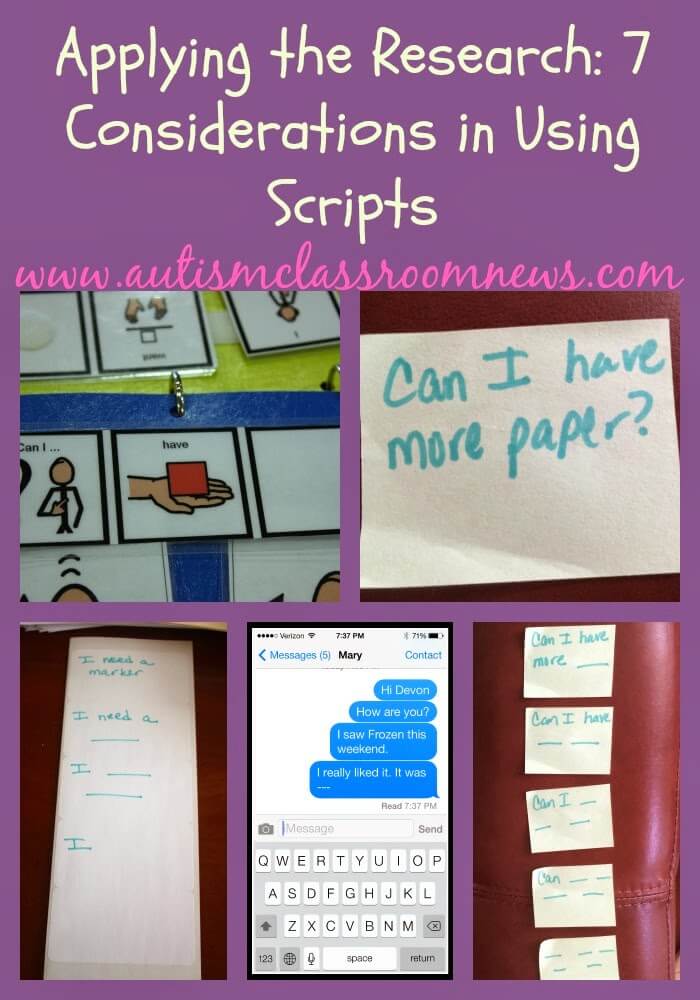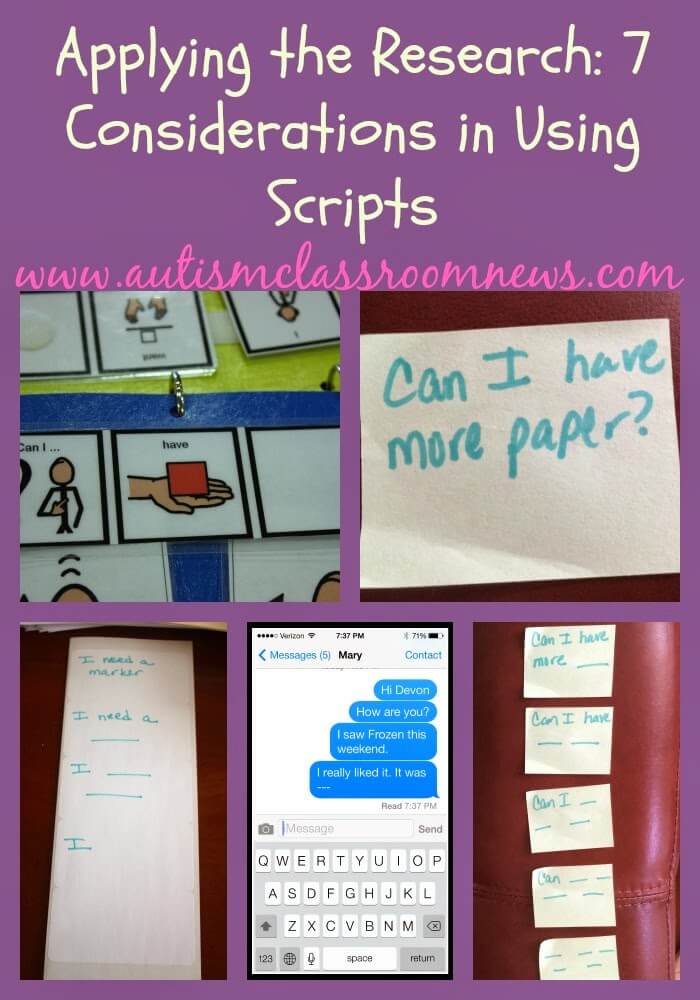If you have been reading, you know I have been talking about the new evidence-based practice report from the National Professional Development Center. You can read about the outcome of the report HERE, the criteria for being considered an evidence-based practice HERE, and about exercise as an EBP HERE. In the last post I talked about scripting and the research behind it. You can read that HERE.
Today I want to focus on 7 things to think about as you implement scripts. You can find the fact sheet from the NPDC here.
1. Scripts are not synonymous with verbal prompts
Don’t confuse scripts with verbal prompts. Verbal prompts, cues, or reminders are typically only used when the student fails to be independent. They might be used in a time delay process where you initially provide them immediately, but they are not designed to be used proactively as a tool the way that scripts are. Instead, use written scripts that state what the individual is to say. For nonreaders you can use recorded statements, but avoid just filling in the blanks for the student and thinking you are providing a script. Giving a student a written statement that says, “I need a ___” and putting it in front of him before sabotaging the environment is using a script that you are fading (dropping the last word). Sabotaging the environment and waiting for the student to ask for help and then saying, “I need a crayon” is a prompt. It’s a script as a prompt, but it’s not making him more independent and able to interact without you. It makes a difference in how we fade them and how successful students are with them.
2. Use it in multiple situations with multiple scripts to enhance generalization
3. Teach them how to use them.
4. Must teach beyond reading / using the script
In addition to teaching students to use the scripts, we have to teach other skills to use them successfully. For instance, we need to teach them to read the script and then look at the communicative partner before delivering the script. We need to teach them to use them at appropriate times (e.g., break in the conversation) and not use them at other times. All of this, and more, takes practice.
5. Fade the scripts
Fade the scripts by reducing the words from the end…leaving off an element
6. Consider voice-output devices with single messages as a script for nonreaders
Some students are not readers. For those students, there is research that shows that you can use a recorded script. Dotto-Fojut et al. (2011) used auditory recordings for one of the participants. Stevenson, Krantz, and McClannahan (2000) also used audio recordings. The single message would give the message you want the student to model and instead of having the student hit the switch to give the message. Clearly a script could be used for verbal students and the switch used as a speech substitution for nonverbal students.
7. Consider common technology like texting
Finally, one of the advantages of scripting is that they don’t require an adult to be in the interaction, which increases the possibility of spontaneous communication as well as improves social interactions between peers. With new technology of smart phones and tablets, as well as iPods, we have the opportunity to use scripts on a piece of equipment that fits right in with peers–who isn’t looking at their phone these days during a conversation? In addition, we have the opportunity to change the script according to the conversation. One of the difficulties with scripts is that conversations don’t always go along with our scripts. If we use texting (with the sound off), we can change the script (assuming the student has practice with this procedure). Be aware that there is not research on this use specifically. Certainly using texts as static prompts would fit with the research we have on text prompts–they are just another form of text. However, we don’t have much research on this technology, which changes faster than the technology, looking at this issue. If you are looking for a good dissertation or thesis topic, this would be one!
So those are just some of the things that we should think about in using scripts. They are extremely useful and in my next post I’ll talk about some creative ways to make scripts (audio and textual) using a variety of materials and technology. For more information, I highly recommend the book below. You might also like a post I wrote on A Special Sparkle on scripts. You can read it HERE.
.
How do you use scripts in your classroom?
Until next time,
References:
Dotto-Fojut, K. M., Reeve, K. F., Townsend, D. B., & Progar, P. R. (2011). Teaching adolescents with autism to describe a problem and request assistance during simulated vocational tasks. Research in Autism Spectrum Disorders, 5(2), 826–833. doi:10.1016/j.rasd.2010.09.012
Fleury, V. P. (2013). Scripting (SC) fact sheet. Chapel Hill: The University of North Carolina, Frank Porter Graham Child Development Institute, The National Professional Development Center on Autism Spectrum Disorders.
Stevenson, C. L., Krantz, P. J., & McClannahan, L. E. (2000). Social interaction skills for children with autism: A script-fading proce- dure for nonreaders.Behavioral Interventions, 15, 1-20.









![Summer resources to help survive the end of the year in special education [picture-interactive books with summer themes]](https://autismclassroomresources.com/wp-content/uploads/2018/05/SUMMER-RESOURCES-ROUNDUP-FEATURE-8528-768x768.jpg)
